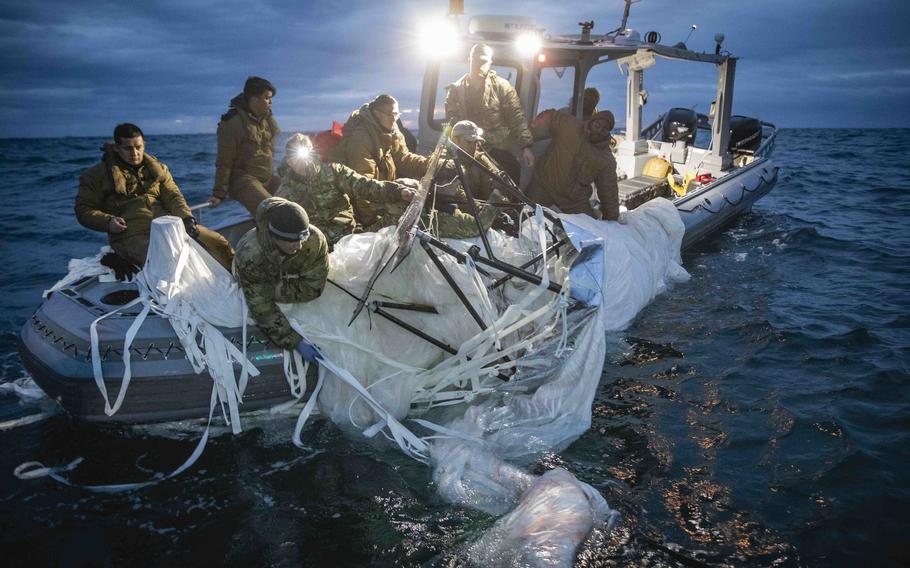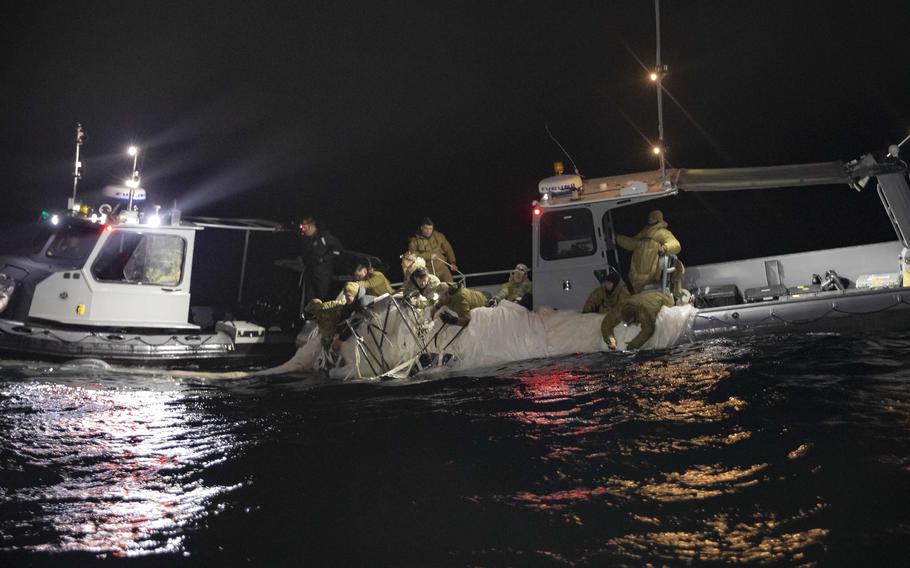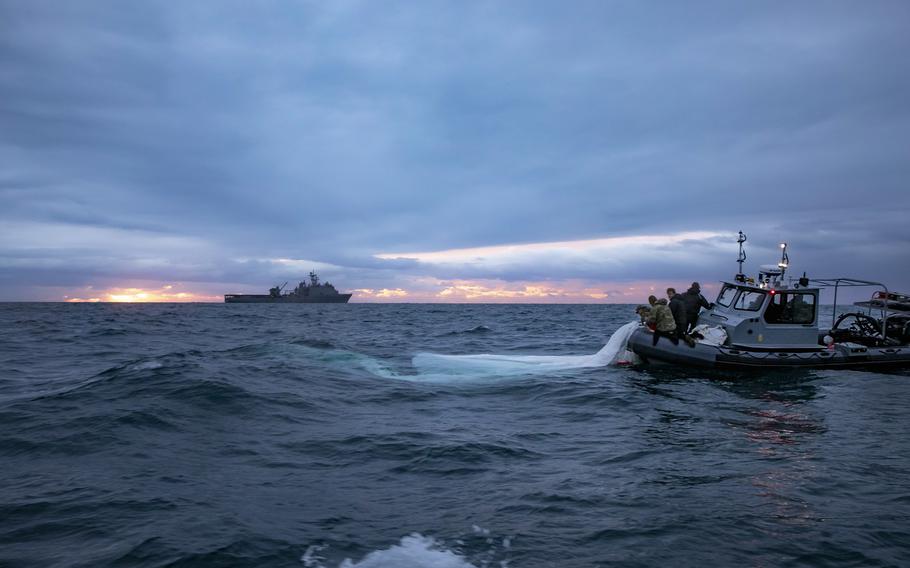
Sailors assigned to Explosive Ordnance Disposal Group 2 recover portions of a Chinese surveillance balloon off the coast of Myrtle Beach, S.C., on Feb. 5, 2023. A U.S. fighter jet shot down the balloon over U.S. territorial waters Feb. 4, 2023. Active-duty troops and Reserve, National Guard, and civilian personnel along with partners from the Coast Guard, Federal Aviation Administration and FBI took part in recovery efforts. (Tyler Thompson/U.S. Navy)
WASHINGTON — Military crews, federal agents and other law enforcement officials on Tuesday continued their search of a debris field off the East Coast looking for parts of the Chinese balloon that U.S. officials accused of spying. The incident has raised concerns about national security and increased tensions with China.
The balloon was first sighted last week near Alaska and U.S. officials said it traveled a southeastern path to a spot off the Carolina coast where it was shot down Saturday by a U.S. fighter jet. The Pentagon said it’s a spy balloon, but China said it was a weather balloon. Officials expect the debris collected offshore will reveal more information about it.
Some experts have weighed in on questions raised by the balloon and Stars and Stripes spoke to a couple of them — Iain Boyd, a professor of aerospace engineering sciences and the director of the Center for National Security Initiatives at the University of Colorado, and Timothy Heath, senior international defense researcher at Rand Corp., a California-based defense think tank.
What was the balloon? Was it a spy ship or a weather ship?
BOYD: It’s almost certainly not a weather balloon. It’s just way too big. And why would they be measuring weather off the coast of the U.S. in this way, anyway? It seems unlikely to me that it’s a fully loaded spy ship because, being that large, it’s definitely going to be detected — and once detected, almost certainly brought down to Earth in some way or another. So you’re going to lose all your latest spy technology this way. None of that makes any sense to me. So I think it’s more likely to be some kind of experimental vehicle. It probably doesn’t have a whole bunch of spy equipment on it. It certainly doesn’t have weather equipment on it. And maybe they lost control of it and it wandered over here.
HEATH: I have been surprised at how much this story has gained legs. It’s become such a hot issue in global media, it really is striking. I think there’s a very strong likelihood that this balloon is carrying out some sort of intelligence collection. The U.S. government would not shoot down a weather balloon if they were not clear on what this thing is. The U.S. government is not going to reveal classified information, but all the hints suggest there is some kind of technical collection. They are aware of the information it’s collecting and what its purposes appear to be. And that’s why they decided to shoot it down.

Sailors assigned to Explosive Ordnance Disposal Group 2 recover portions of a Chinese surveillance balloon off the coast of Myrtle Beach, S.C., on Feb. 5, 2023. (Tyler Thompson/U.S. Navy)
Did President Joe Biden’s administration make the right call in waiting for the balloon to reach the Atlantic Ocean before bringing it down? Or should it have been taken out immediately?
BOYD: The size of the payload underneath the balloon is like three buses in size. So if that’s true, having three buses drop out of the sky over the continental U.S., you’d have to do that very carefully. You’d have to see where the balloon was and try and project where the [debris] would go and be sure that it was a very sparsely populated area of the country. There certainly is some risk associated with that, so shooting it down over the ocean is much, much safer. Also, there could have been an element of letting this play out a little bit, from the administration’s point of view. All the attention it’s gotten globally — this kind of looks like an example of China behaving badly, not following the established norms of behavior. We don’t know at this point, but I think those are elements of what went into that decision. We don’t know all the information that went into deciding when to shoot it down, but certainly doing it over the ocean is by far the least risky way to do it.
If it was a surveillance balloon, why would China use such a low-tech method to collect U.S. information?
HEATH: Satellites have their downsides. They operate on predictable orbits, so if you want to deny information to a passing satellite it’s not that hard to do. You know when it’s coming. Balloons mitigate that because they are hard to detect. Most air-defense radars are not designed to pick up on balloons. They’re designed to pick up missiles and aircraft. Balloons also offer the advantage of dwell time. With rudders or propellers, you can exert some level of control and keep a balloon stationary. So there are military reasons why a balloon might be attractive to China in their pursuit of intelligence collection.
What might have been China’s possible motivations?
BOYD: It could just be China poking the U.S. in the eye a little bit and causing us quite a stir over here. China has complained for many years about the U.S. spying on them, and in some ways, this is a way for China to say, “Look, we can reach out and cause you aggravation, too.” It could be a way of testing out the U.S. response in a situation where you have something like this in your airspace. It’s hard for me to believe that the Chinese are so incompetent that they built this giant spy balloon and then expected it to be sighted and brought down. That’s incompetence at a level that’s hard to believe.
HEATH: In the past, there were numerous balloons stretching all the way back to [former President Donald Trump’s administration], and they were not discovered. So, these [balloons] are not obvious things. I think it’s possible at 60,000 feet that whoever launched the balloon believed they could get away with not being noticed. It just happened to be spotted this time, probably because it stayed in one place. The other times, these airships just drifted by, and the media and the U.S. government apparently missed them. This incident reveals the depth of distrust between the two countries. China, for some reason, has a fear and an intense interest in U.S. nuclear capabilities, which is frightening in itself. It’s understandable they want to better understand America’s nuclear missile silos, but that’s a worrying sign in my view — that both countries are feeling more and more threatened by the other side.

Sailors assigned to Explosive Ordnance Disposal Group 2 recover portions of a Chinese surveillance balloon off the coast of Myrtle Beach, S.C., on Feb. 5, 2023, while the Harpers Ferry-class, dock landing ship USS Carter Hall transits nearby. (Tyler Thompson/U.S. Navy)
Biden and the Pentagon have voiced repeated concerns about China’s rising influence in the Indo-Pacific region and toward Taiwan. Does the balloon incident validate those worries?
HEATH: The Pentagon is deeply sensitive to the reality of flat budgets and declining military capabilities, and extremely worried that U.S. military muscle just isn’t what it used to be. I think U.S. military leaders are very worried that the credibility of U.S. intervention near Taiwan is just so in doubt now. Unless the U.S. has nuclear missiles to back up its nuclear credibility, it could be a motivator for China to start challenging the U.S. with armed force. In a more unstable world with a shrinking U.S. military, the interest in nuclear missiles is probably going to grow. And the role nuclear weapons play in U.S. defense — I hate to say it — but I see it growing, as well.
The Pentagon said part of the concern about shooting down a spy balloon is it might have had explosives to self-destruct. Is that a possibility?
BOYD: If it was a spy balloon and it’s got the latest technology from China for spying, I would think it would have a self-destruct mechanism. And maybe the self-destruct failed. If you’re in China’s shoes and this thing is drifting toward the U.S. and has been detected, yes, you’d want to destroy it. You don’t want all your stuff to be picked over by the FBI or whoever. This is going to be a treasure trove, perhaps, for the U.S. intelligence services.
The balloon led to Secretary of State Antony Blinken canceling a trip to China. What does this ordeal do for U.S.-Chinese relations?
HEATH: It does not look good for China. It shows at the very least the Chinese government is not well coordinated. There are people [in the Chinese government] operating and Beijing is not really tracking what they’re doing. The timing was terrible. The Chinese desperately want to ease tensions with the U.S. They were looking forward to Blinken’s visit … and this totally derailed it.
Where does the U.S. go from here with China, diplomatically?
HEATH: The U.S. needs to slow the momentum toward repairing ties, just to make sure Beijing gets the message that this kind of behavior is not acceptable. It’s true the two countries spy on each other all the time, but deploying some kind of craft above the territory of another country, in its airspace, that is new and that is offensive. And there’s no reason the U.S. should beg China to come back to the table. The U.S. has the upper hand here and should slow things down. I think it’s the right thing to delay, but not cancel, the Blinken visit and let the Chinese stew and fume over their mistake.